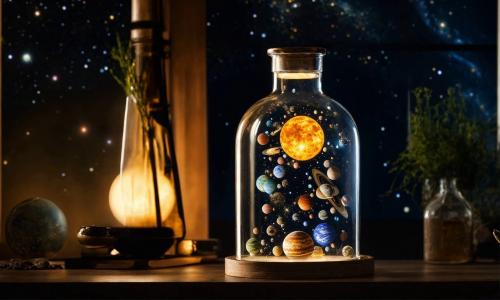When Science and Art Collide in a Bio-Freakshow

Ladies, gentlemen, and sentient houseplants, gather 'round! Welcome to today's wild ride into the bonkers world of BioArt and Living Sculptures, where the mystical realms of biology and art collide like a Hollywood blockbuster crossover no one saw coming. Picture this: Tony Stark tinkering with genetically modified daisies while Groot recites Shakespeare to an audience of bioluminescent fungi. Ka-POW! We’re diving headfirst into the surreal universe where plants glow in the dark, fungi dance in Petri dishes, and bacteria have better fashion sense than most Instagram influencers. Buckle up, because this is going to be a rollercoaster of wacky wonders and scientific shenanigans!
First off, let's talk about BioArt, the avant-garde genre that makes regular art look like finger-painting in kindergarten. Imagine Leonardo da Vinci with a lab coat, splicing genes like he's mixing paint. Here, artists play god—literally—by engineering living organisms into their masterpieces. It's like if Banksy decided to tag the Mona Lisa with genetically modified glow-in-the-dark spray paint. If that doesn't scream "lit," I don't know what does.
Our first stop on this tour of bio-wizardry is the mesmerizing world of genetically engineered plants. Think of it like Frankenstein meets The Secret Garden. Imagine a garden where every plant is a botanical disco ball, glowing with the intensity of a thousand rave parties. This isn’t just horticulture; it’s hard-core horti-cool-ture. We've got researchers splicing bioluminescent genes from jellyfish into plants, turning your average house fern into a nightlight that’ll make your bedside lamp look like a useless antique. Your succulents just went from "meh" to "whoa" in the blink of a phosphorescent leaf.
And let's not forget our fungal friends, the unsung heroes of the BioArt revolution. Picture this: mushrooms that glow brighter than a thousand LED light strips, creating eerie, ethereal landscapes right out of a Tim Burton fever dream. These fungi are like the goth kids of the biological world, all moody and mysterious, yet undeniably cool. They don't just sit there in the dark—they glow with a supernatural aura that makes them the ultimate night-time décor. Move over, fairy lights; bio-luminescent mushrooms are the new hotness.
But hold onto your hats, because we’re not done yet. Enter the realm of living sculptures, where bacteria become the brushstrokes of a new artistic era. This isn't your grandmother’s pottery class; it’s like Jackson Pollock had a love child with a microbiologist. Artists are now using genetically modified bacteria to create living, growing art pieces that evolve and change over time. It’s like your artwork has a mind of its own, which is both thrilling and a bit creepy. Imagine a sculpture that not only looks back at you but might also be planning its escape. Talk about interactive art!
One of the most mind-boggling examples of this biological art madness comes from the realm of bioluminescent bacteria. These tiny glowbugs can be engineered to form patterns, shapes, and even detailed images on petri dishes. Imagine Mona Lisa, but instead of paint, she's composed of millions of glowing bacteria. The Louvre would never be the same again. And for those who think bacteria are gross, think again! These little critters are the ultimate eco-friendly artists, requiring nothing more than a nutrient-rich agar canvas and a bit of genetic wizardry.
Now, let’s spice things up with some contemporary pop culture references, because why not? Imagine if Thanos decided to ditch the Infinity Stones and take up BioArt. Instead of snapping his fingers and erasing half the universe, he’d be splicing genes to create gardens that glow in the dark and fungi that dance to the beat of "Old Town Road." Or consider if Elon Musk, in between launching rockets and tweeting cryptic memes, decided to invest in a startup that grows bioluminescent Christmas trees. Forget traditional holiday lights; these trees would light up the neighborhood and probably sync to your Spotify playlist.
And speaking of memes, can you even imagine the viral potential here? Picture it: a TikTok video featuring a glowing garden set to the latest dance craze, or an Instagram influencer posing with a luminescent bonsai tree that’s brighter than their future. Hashtag #BioArtGoals. The social media game would never be the same again, and neither would our understanding of art and biology. When science meets art in this fantastical BioArt circus, the boundaries of creativity are not just pushed—they’re utterly obliterated.
But before we get too carried away in our bio-psychedelic daydreams, let's take a moment to appreciate the sheer brilliance behind these creations. It’s not just about the wow factor; there’s genuine scientific and artistic genius at work here. These BioArt pioneers are pushing the boundaries of what we consider possible, blending the meticulous precision of genetic engineering with the boundless creativity of artistic expression. They’re not just making art—they’re making living, breathing statements about the future of creativity and the fusion of disciplines.
In conclusion, dear students, BioArt and Living Sculptures are not just the future—they’re the now. As we navigate this bizarre and beautiful intersection of biology and art, remember to keep your minds open and your imaginations wild. Whether it’s glowing plants lighting up our nights, fungi dancing in the dark, or bacteria crafting masterpieces, the world of BioArt is a testament to the limitless possibilities that arise when science meets art. So next time you see a glowing garden or a living sculpture, take a moment to appreciate the mad brilliance behind it. And maybe, just maybe, give a little nod to Professor Pop and their wacky, wonderful tales of bio-artistic shenanigans.
And with that, class is dismissed! Go forth and create your own bio-masterpieces. Just don’t let your pet bacteria start a revolution.


Comments